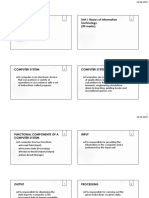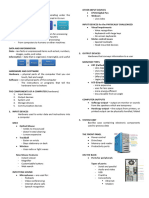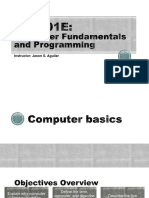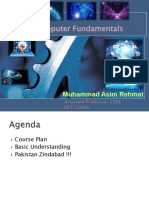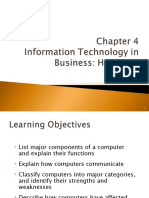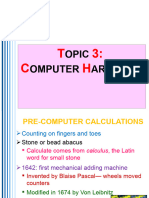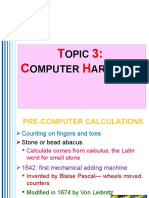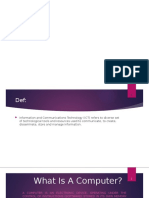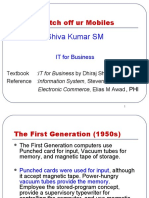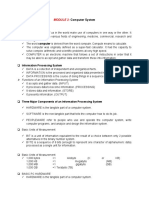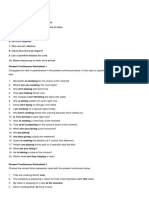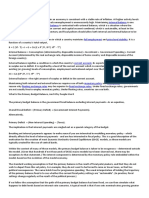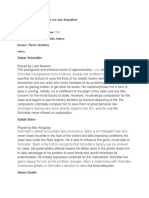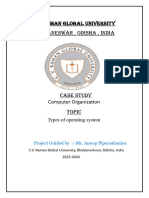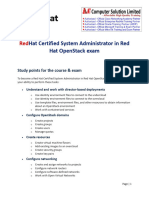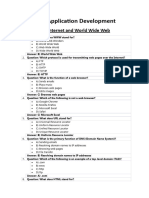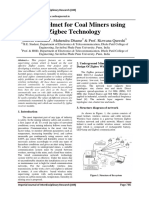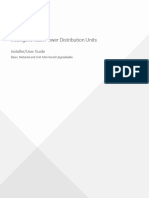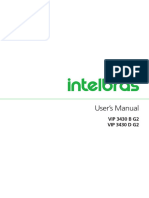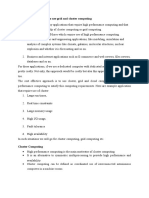Information Technology
COMPUTER is an electronic machine that
follows a set of instructions in order that it
may be able to accept and gather data and
transform these into information.
DATA is a collection of independent and
unorganized facts.
DATA PROCESSING is the course of doing
things in a sequence of steps.
INFORMATION is the processed and
organized data presented in a meaningful
form.
�PROCESSING
SYSTEM
DATA
INFORMATION
�1.
2.
3.
4.
It accepts and gather data. (INPUT)
It processes data to become
information. (PROCESSING)
It stores data and information.
(STORE)
It presents information. (OUTPUT)
�HARDWARE is the tangible part of a
computer system.
SOFTWARE is the non-tangible part
that tells the computer how to do its
job.
PEOPLEWARE refer to people who use
and operate the computer system,
write computer programs, and analyze
and design the information system.
MICROCOMPUTER (Personal Computer) is
most widely used especially at home
because of its affordable price and
manageability.
MINICOMPUTER perform multi-tasking and
allow many terminals to be connected to
their services.
MAINFRAME are large general purpose
computers.
�MAINFRAME
COMPUTERS
MINICOMPUTERS
MICROCOMPUTERS/
PERSONAL
COMPUTERS
8
HARDWARE is the tangible part of a computer
system.
Central Processing Unit (CPU)
Memory Unit
Input Devices
Output Devices
Secondary Storage Devices
10
Brain of the computer.
It directs and controls the entire computer
system and performs all arithmetic and
logical operations.
11
Where the programs and data
are stored .
READ ONLY MEMORY (ROM)
contains the pre-programmed
computer instructions such as the
Basic Input Output System (BIOS).
RANDOM ACCESS MEMORY (RAM)
is used to store the programs and
data that you will run. Exists only
when there is power.
12
�13
Allows data and programs to be sent to the
CPU.
Keyboard
Mouse
Joystick
Microphone
Webcam
Scanner
Monitor
14
Traditional keyboards
Flexible keyboards
Ergonomic keyboards
Wireless keyboards
PDA keyboards
15
Mechanical - a type of
computer mouse that has a
rubber or metal ball on its
underside and it can roll in
every direction.
Optical: This type uses a
laser for detecting the
mouse's movement.
16
PS/2 Mouse
Serial Mouse
USB
Cordless Mouse
17
Trackball
Track point
Touch pad
Touch Screen
18
Joystick input device for
computer games
Light Pens light-sensitive
penlike device
Stylus penlike device
commonly used with tablet
PCs and PDAs.
19
Optical scanners
Card readers
Bar code readers
Character and mark recognition devices
20
Digital Cameras
Digital Video Cameras
21
An ADC (Automated Data Collection) technology
uses radio-frequency waves to transfer data
between a reader and a movable item to identify,
categorize, track..
Is fast and does not require physical sight or contact
between reader/scanner and the tagged item.
Performs the operation using low cost components.
Attempts to provide unique identification and
backend integration that allows for wide range of
applications.
22
�23
�Biometrics authentication (or realistic
authentication) is used in computer science
as a form of identification and access
control. It is also used to identify
individuals
in
groups
that
are
under surveillance.
Types
Fingerprints
iris scans/retinal scans
face scans, and other personal information that
is more difficult to forge.
24
�FACE RECOGNITION
25
�FINGER SCAN
26
�IRIS / RETINA SCAN
27
Media used by the computer in displaying its
responses to our requests and instructions.
Monitor
Audio Speakers
Printer
28
Cathode Ray Tube (CRT)
Liquid Crystal Display (LCD)
29
IMPACT PRINTERS uses pressure by physically
striking the paper. Ex. Daisy wheel printers,
line printers, dot matrix printers & band
printers.
NON-IMPACT PRINTER does not apply
pressure on the paper but instead produces
character by using lasers, ink spray,
photography or heat.
30
�Dot matrix
printer
Laser
printer
Inkjet printer
31
Attached to the computer system to allow you
to store programs and data permanently for
the purpose of retrieving them for future use.
Diskette, Hard disk, CD Rom, External
HardDrive, Memory Card
32
The most common secondary storage device
before but has been obsolete.
3.5 disk 1.44MB
33
Floppy disk cartridges
3 inches in diameter
Stores more information
Zip disks
34
Made of rigid materials unlike floppy disks
Holds a greater amount of data
10MB in 1980s
600MB in mid 1990s
4.3GB in 1999
180GB in 2001
400GB - 2004
35
A standard part of modern desktop machines,
especially used for multimedia purposes and
preferred in loading applications.
36
Blue Ray Disk 40G
Digital Versatile Disk
DVD-R write once, 3.95G
DVD RW rewritable, 3G
Single Layer and Double Layer
Compact Disk
CD-R write once, 650MB
CD-RW rewritable, 700MB
37
CD-ROM
CD-Writer
DVD-Combo
DVD Writer
read CDs
read/write
read/write
read/write
read/write
CDs
CDs, read DVD
CDs
DVDs
38
Solid-State Storage
No moving parts
Flash memory cards
USB flash drives
39
Casing or cover
Power Supply
Motherboard
Microprocessor
Memory
Video Card
Sound card
Floppy disk drive
Hard disk drive
CD-ROM drive
MODEM
40
The box or outer shell
that houses most of the
computer, it is usually
one of the most
overlooked parts of the
PC.
Protects the computer
circuits, cooling and
system organization.
41
Responsible for powering every device in
your computer.
Uninterrupted Power Supply (UTP)
Will not shut off for almost an hour even without
electricity
42
The physical arrangement in a computer
that contains the computers basic circuitry
and components.
Components are:
Microprocessor
(Optional) Coprocessors
Memory
Basic Input/Output System (BIOS)
Expansion Slot
Interconnecting circuitry
43
�44
Instructions that tell the computer how to
process data into the form you want.
Software and programs are interchangeable.
Two major types:
System and Applications
45
�1.System Software enables the application
software to interact with the computer hardware.
Operating
Systems
are
programs
that
coordinate computer resources, provide an
interface between users and the computer; and
run applications.
Utilities perform specific tasks related to
managing computer resources.
Device drivers are specialized programs
designed to allow particular input or output
devices to communicate with the rest of the
computer system.
46
Managing resources (memory, processing,
storage, and devices like printer).
Providing user interface
Running applications
47
�2.
Applications Software - provides the real
functionality of a computer. It help you use
your computer to do specific types of work.
Basic Applications, widely used in all career areas.
Specialized Applications, more
narrowly focused
on specific disciplines and occupations.
48
A computer network or data network is
a
telecommunications
network
which
allows computers to exchange data. In
computer networks, networked computing
devices exchange data with each other using
a data link.
The
connections
between
nodes
are
established
using
either
cable
media or wireless media. The best-known
computer network is the Internet.
49
Connecting devices enable the hardware to
communicate with each other
A parallel connector is used to plug a printer into a
system box
Parallel connector interfaces with a parallel port
that is connected to an expansion card
50
Connectivity software
enables a computer to dial up or connect to
another computer
Web browser software
enables a computer to surf the Web
E-mail software
enables electronic communication with other
people by sending and receiving e-mail
51
Infrared also called IR or IrDA (infrared data
association) - uses red light to send and receive
information
Bluetooth - standard for transmitting information
in the form of short range radio waves over
distances of up to 30 feet and is used for purposes
such as wirelessly connecting a cell phone or a PDA
to a computer
WiFi (wireless fidelity) - standard for transmitting
information in the form of radio waves over
distances up to about 300 feet
52






